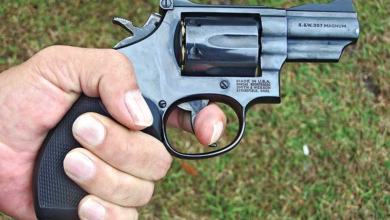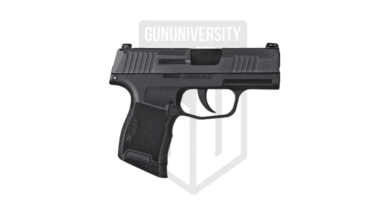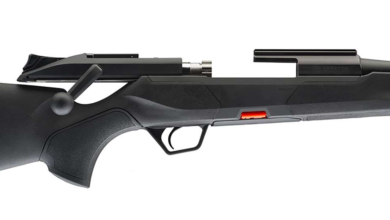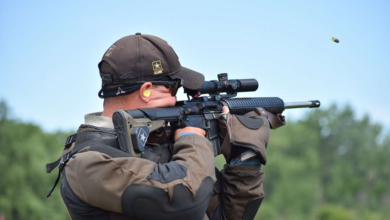The Cimarron Remington 1875 Outlaw .45 Colt Revolver
The Cimarron-imported Uberti-built Remington 1875 Outlaw .45 Colt revolver is as sturdy and unmistakable today as it was in the Old West.
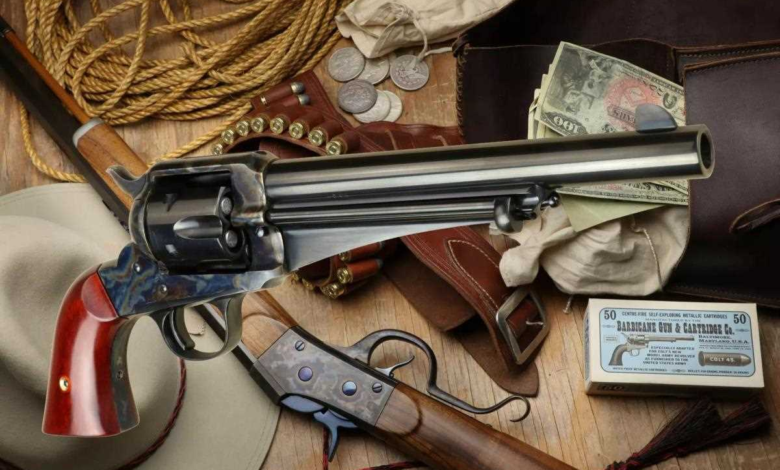
There is no mistaking a Remington 1875 revolver with any other six-gun even at a distance. Highly distinctive with its under-barrel web and curved grip, the 1875 had much to recommend it to pistoleros in the Old West, marred initially when offered in an already obsolete proprietary cartridge (even by 1875 standards) and one that no one else chambered. The Cimarron is chambered in .45 Colt, a caliber (along with the .44-40) Remington offered a little later in the 1875’s life to boost sales.
The Cimarron-imported Remington 1875 built by Uberti of Italy is the cleanest version available to shooters today. Cimarron demands a little more attention to detail from Uberti and has as many of the non-essential external markings like catalog number and various proofs and date codes placed under the grip. BATF regulations mean some external proofs are necessary but even they are discreetly stamped giving Cimarron revolvers a cleaner exterior than other importers, including Uberti itself. Ours was no exception and the beautiful fit and finish were marred only by a small, uncharacteristic gap between the wood of the grip and frame on the right side.
Having a solid frame and grip gave far greater structural strength than most of the Remington’s rivals and used far fewer screws than its chief rival in the Colt Peacemaker. If you’ve ever shot a Colt SAA (Single Action Army) extensively, you’ve learned to keep a screwdriver handy to keep the six backstrap/trigger-guard screws tight. The Remington has five screws externally and two more inside. They rarely loosen.
Unlike the Colt SAA that required a screwdriver for removal of the cylinder until the mid 1890s, the 1875 could be field stripped without tools. Originally, to remove the cylinder, you simply depressed a spring under the cylinder pin at the end of the web and drew out the rod until it stopped. Uberti took the expedient step of adding the later Colt SAA-style cross-pin latch in the frame rather than the difficult-to-machine part fitted into the end of the cylinder pin of the original. While somewhat sullying the otherwise clean lines of the Remington’s frame, the benefit of this cylinder pin release means these 1875s still don’t require tools for field stripping.
Another welcome touch, Uberti has also increased the diameter of the cylinder pin, a wise decision in a pistol built for smokeless powder. Another departure from the original is the use of a steel Colt SAA-style front sight. When switching from the Civil War-era “pinched” front sight to the Colt-style blade, Remington used German silver for the blade. The other departure is a fully case-hardened frame. Original Remingtons had a full blue frame and barrel with a case-hardened hammer and loading gate. Complimented with heat-blued screws and trigger, the gun was very beautiful.
To be imported into the USA, these cowboy six-shooters have to be drop-safe. For a very long time, users of single actions knew to load five and lower the hammer over an empty chamber. If six were loaded and the hammer put in its safety notch, if the revolver were dropped and landed on the hammer, the notch, sear or both could shear and fire the gun. Lowering the hammer over an empty chamber quickly became the safest way to carry and still is today. Uberti has added a clever, unobtrusive safety. In this Remington (and most current SAAs, too), the hammer is hollowed in the center for the safety parts. These include a plunger mounted in the first safety notch that the trigger/sear raises so a small external block farther up the hammer lowers between the hammer and frame to keep the firing pin from contacting a primer. An internal spring moves the block out of the way when on half or full cock.
To load five in the 1875, point the gun safely downrange. Pull the hammer to the half-cock position. The cylinder stop is lowered, allowing the cylinder to spin clockwise. Open the loading gate, insert a cartridge, leave the next chamber empty, and load four more. Full-cock the hammer and lower it. It should rest on an empty chamber. Rotate the gun in your hand, looking to see that there is no cartridge under the hammer. To unload, half-cock the hammer, place the gun in your left palm and open the loading gate. Use your right hand to run the ejector rod, punching out the empties. Rotate the cylinder with your left thumb, and repeat.
As an aside, never lower the hammer from half cock to full rest. Doing so raises the cylinder bolt into contact with the cylinder outside of its locking notch. If the cylinder is rotated, you’ll put an unsightly scratch in the cylinder’s finish.
The tall, thin, steel front sight is matched to a wide rear notch. For me the sight picture is a little more open than optimal, causing some horizontal stringing, but is typical of an Old West six-gun. Groups at 25 yards with Winchester and Hornady Cowboy loads were in the 2½- to 3-inch range. Most were a little high and left. Dropping the blade deeply in the rear notch helped with the elevation, but not the windage. The easy fix was to aim a little off the 3-inch Birchwood Casey Shoot-N-C target. The trigger breaks at a delightfully light, crisp 2¼ pounds.
The benefit of fixed sights is sturdiness. The curse is if they aren’t regulated, the fix requires a skilled gunsmith. This is why you sometimes see a front sight dovetailed into the barrel. Wild Bill Hickok had such sights on his .36 Colt Navy revolvers and one of those is on display at the Buffalo Bill Museum in Cody, Wyoming. Another method to fix the windage involves turning the barrel in or out slightly, and that also requires a skilled gunsmith. Or you can be just like an old-time cowboy and just learn where to point your gun.
If there is a downside to the Remington, it is the egregiously shaped grip. The gun just doesn’t feel quite right, especially for those of us who have used the Colt SAA extensively. Some blame the long web under the barrel, but the 1890 Remington lacks that web and still points funny. I’ve shot a lot of Old West six-guns, and the 1875 is one of the least natural feeling of them all.
Nonetheless, the Remington is growing on me. Its best points are the hammer is very easy to reach, and when I aim the gun with my eyes closed, I am looking straight down the sights when I open them. The big revolver rolls comfortably in the hand under recoil placing the hammer within easy reach for the next shot. Such natural operation and pointability is endearing to me, no matter how “funny” I perceive the feel. The Uberti grips are a little fatter than I like but, sadly, few make aftermarket ones. I plan on searching out a pair to improve the fit and feel. Better news is the Remington 1875 fits most holsters for the Colt SAA, although it is best to confirm that with the maker.
The name Outlaw on these repros reflects the most famous of its users in Frank James of the James Gang. The Cimarron 1875 allows us to appreciate this iconic Old West revolver in an accurate reproduction for shooting games where you can be on either side of the law or just for fun. Contact them for a dealer near you.
Cimarron 1875 Outlaw
- Type: Single-action revolver
- Caliber: .45 Colt (tested), .45 Colt/.45 ACP (dual cylinder), .44-40, .357 Magnum
- Capacity: 6
- Barrel: 7½ in.
- OAL/Height/Width: 13/5/1 11/16 in.
- Weight: 41.7 oz.
- Construction: Steel
- Sights: Fixed tapered blade front, square notch rear
- Trigger Pull: 2¼ lbs.
- Safety: Internal hammer block on 1/4-cock
- Price: $689.34
- Manufacturer: Cimarron Firearms

